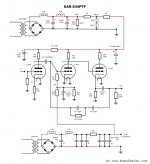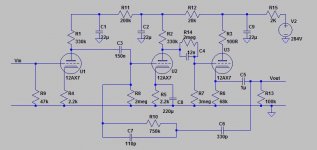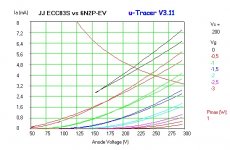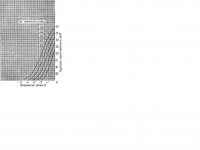Can someone speak to similarities and differences between 6N2P-EV and 12ax7, given that:
Both are wired for their correct pin out @6.3V in the same circuit and the power transformer has adequate current for either.
(I believe 6N2P requires 40ma or so of additional current over a 12ax7)
Some have said 6N2P-EV to be more closely related to a 6SL7.
I’d rather not rehash the better known differences, but instead get down to what might be some differences “beneath the surface”
Opinions abound as to where they stand in the scheme of things. With the best NOS 12ax7’s in “absurd” cost territory, what do you all thing of the 6N2P-EV’s worth in circuits traditionally with 12ax7’s?
What are the relevant differences we might need to consider?
My understanding is that if the 6N2P-EV is an equivalent, it would be at least in theory superior to the 12ax7 as from what I gather it has a grounded shield on pin 9 to reduce crosstalk? They also seem to be rated for more hours and are built to be more robust (for mil application). They are also WAY cheaper than a 12ax7 Telefunken!
By the same token I’ve also heard 6N2P-EV has more fluctuation from sample to sample.
I have swapped 6N2P-EV and 12ax7 and heard repeatable differences, but I’m not sure if the same would probably be true if I swapped 12ax7 for 12ax7 of different make or manufacture. I.e. just normal variance.
I didn’t do double blind testing. I’m just not set up for it, so take my casual observations with a grain of salt.
Unfortunately also i don’t have a curve tracer or I’d do some detective work... but I’m greedily eyeing the uTracer so that might come to fruition sooner rather than later.
So, I figured I’d ask those much more adept than myself:
Can I assume the 6N2P-EV is a drop in, given attention to the above or is there something I’m missing?
Are the data sheets accurate to real world samples? Same operating points?
I wonder if anyone out there has gone through and tested a couple dozen or so of these from different factories and can provide some info as to their spread as well.
What are the best years and factories?
Are there other 6N2P suffixes that are superior? I believe EV is a ruggedness criteria.
As an aside: Someone I spoke to who was from Russia mentioned that from Gorbachev onward the quality of tubes and other mil parts was not the same. He said he definitely wouldn’t buy tubes manufactured in Russia after 1991 but ideally none before the mid-80s. Do others share this view?
Thanks in advance for your thoughts and insights.
Both are wired for their correct pin out @6.3V in the same circuit and the power transformer has adequate current for either.
(I believe 6N2P requires 40ma or so of additional current over a 12ax7)
Some have said 6N2P-EV to be more closely related to a 6SL7.
I’d rather not rehash the better known differences, but instead get down to what might be some differences “beneath the surface”
Opinions abound as to where they stand in the scheme of things. With the best NOS 12ax7’s in “absurd” cost territory, what do you all thing of the 6N2P-EV’s worth in circuits traditionally with 12ax7’s?
What are the relevant differences we might need to consider?
My understanding is that if the 6N2P-EV is an equivalent, it would be at least in theory superior to the 12ax7 as from what I gather it has a grounded shield on pin 9 to reduce crosstalk? They also seem to be rated for more hours and are built to be more robust (for mil application). They are also WAY cheaper than a 12ax7 Telefunken!
By the same token I’ve also heard 6N2P-EV has more fluctuation from sample to sample.
I have swapped 6N2P-EV and 12ax7 and heard repeatable differences, but I’m not sure if the same would probably be true if I swapped 12ax7 for 12ax7 of different make or manufacture. I.e. just normal variance.
I didn’t do double blind testing. I’m just not set up for it, so take my casual observations with a grain of salt.
Unfortunately also i don’t have a curve tracer or I’d do some detective work... but I’m greedily eyeing the uTracer so that might come to fruition sooner rather than later.
So, I figured I’d ask those much more adept than myself:
Can I assume the 6N2P-EV is a drop in, given attention to the above or is there something I’m missing?
Are the data sheets accurate to real world samples? Same operating points?
I wonder if anyone out there has gone through and tested a couple dozen or so of these from different factories and can provide some info as to their spread as well.
What are the best years and factories?
Are there other 6N2P suffixes that are superior? I believe EV is a ruggedness criteria.
As an aside: Someone I spoke to who was from Russia mentioned that from Gorbachev onward the quality of tubes and other mil parts was not the same. He said he definitely wouldn’t buy tubes manufactured in Russia after 1991 but ideally none before the mid-80s. Do others share this view?
Thanks in advance for your thoughts and insights.
Last edited:
There are so many variations among tubes, noise, distortion, micro-phonics, gain, etc. versus others of the same type.
Here are a couple of differences in the maximum allowed specs of the 6N2P versus the 12AX7 and 12AX7A
6N2P: Plate 1 Watt, Grid resistor 0.5 Meg Ohm
12AX7: Plate 1 Watt, Grid resistor 2.2 Meg Ohm
12AX7 long plate and 12AX7A: Plate 1.2 Watt, Grid resistor 2.2 Meg Ohm
Many good circuits will not push any of these to the max limits, others will.
I seem to remember that one of the "Vacuum Tube Valley" magazines tested a very large number of 12AX7 types.
I had seen it online sometime ago.
Here are a couple of differences in the maximum allowed specs of the 6N2P versus the 12AX7 and 12AX7A
6N2P: Plate 1 Watt, Grid resistor 0.5 Meg Ohm
12AX7: Plate 1 Watt, Grid resistor 2.2 Meg Ohm
12AX7 long plate and 12AX7A: Plate 1.2 Watt, Grid resistor 2.2 Meg Ohm
Many good circuits will not push any of these to the max limits, others will.
I seem to remember that one of the "Vacuum Tube Valley" magazines tested a very large number of 12AX7 types.
I had seen it online sometime ago.
Last edited:
Some useful past discussions I’ve found:
6N2P-EV gain factor ??
miniatures 6n1p 6n2p
12ax7(ecc83) and 6n2p 12ax7...........differents??
Some measurements:
Tube Tester Files - 6N2P - 6H2P
6N2P-EV gain factor ??
miniatures 6n1p 6n2p
12ax7(ecc83) and 6n2p 12ax7...........differents??
Some measurements:
Tube Tester Files - 6N2P - 6H2P
Good day from Greece! I use these tubes in my preamp. The preamp is audio symphonies plus-r. I buy this device before 7 years,from ebay from hong kong.The circuit inside looks like a copy of marantz 7 or 8,i do not remember clear. It is line preamp,with 4 line inputs.It came with 3 12ax7 shuguang tubes and 1 6x4 tube rectifier used as soft start device.
The power supply is stabilised with ss rectifiers and huge capacitors with some transistors used as voltage stabilisation in pcb. The sound of this thing is quite good and acceptable,but it has some compression in music bass notes.The problem solved fast,i remove the 6X4 tube who works like a compressor,with huge voltage drop,which i do not liked!
After this mod the sound is much better but is not good to my taste.After some tube rolling,the best sound came with reissue mullard ECC83,and original telefunken Ecc83,special grade from old EGC machine.The last tube which test is 6N2P-EV i change the filament connection and surprise!! The best sound came,crystal clear in highs perfect tubey mids and strong bass,better sound than telefunken tubes.The perfect sound for me! These tubes is very cheap ,very robust,and sound fantastic!
After 7 years of heavy use,the tubes become noisy,with crackles and hiss,excellent life span.I change it with the same and everything is ok. PS These tubes has the rocket sign,and i think is voskhod military tubes,the best replacement tube for the western 12ax7/ECC83 ,excellent quality,low price much better than NOS tubes,and new production tubes!
The power supply is stabilised with ss rectifiers and huge capacitors with some transistors used as voltage stabilisation in pcb. The sound of this thing is quite good and acceptable,but it has some compression in music bass notes.The problem solved fast,i remove the 6X4 tube who works like a compressor,with huge voltage drop,which i do not liked!
After this mod the sound is much better but is not good to my taste.After some tube rolling,the best sound came with reissue mullard ECC83,and original telefunken Ecc83,special grade from old EGC machine.The last tube which test is 6N2P-EV i change the filament connection and surprise!! The best sound came,crystal clear in highs perfect tubey mids and strong bass,better sound than telefunken tubes.The perfect sound for me! These tubes is very cheap ,very robust,and sound fantastic!
After 7 years of heavy use,the tubes become noisy,with crackles and hiss,excellent life span.I change it with the same and everything is ok. PS These tubes has the rocket sign,and i think is voskhod military tubes,the best replacement tube for the western 12ax7/ECC83 ,excellent quality,low price much better than NOS tubes,and new production tubes!
The lower input capacitance, and shield between sections will make the 6N2P a good choice for use where you would normally see the 12AX7, but with a few considerations that may make a difference for you...
The heater wiring/pinout is the big one, but if building from the ground up, a non-issue. The shield makes it worth it for sure.
They are a pretty variable tube, as expected of cold-war era bulk lot tubes... Do not assume you are getting twin matched sections in each bottle, unless you are specifically purchasing tubes that have tested/matched section. The 6N2P-EV is better in this regard, but not terribly so. If your circuit relies on matched section to function correctly, you are better off buying a bunch, and matching sections yourself, or paying extra for matched ones. Or, use them in applications that are either adjustable for mismatch, use balancing schemes (differential with CCS tail, etc) or use them in situations where the mismatch doesn't matter (IE, a concertina splitter) so it's a non-issue.
Some can draw grid current when you get close to the zero-volt part of the curve... higher voltages can help prevent this, but the 12AX7 is about the same in this regard. If used at an input position, just keep the grid resistance at a reasonable amount and don't worry.
All that having been said, I'll take a bog-standard 6N2P over most variety of 12AX7 most any day, and I really like them. The EV types are pretty nice for sure, but they have a shorter life, and cost more. I'm not convinced that they are really needed in most applications that aren't pushing the envelope, or in physically demanding environments, such as guitar amps, or other high abuse areas.
I hear plenty of people say it's more like a 6SL7, but I've not really noticed too much of a similarity, at least not more than the 12AX7/6SL7 have in common. I also use them in situations that tend to have conservative operating points, and use cathode degeneration, as well as GNFB, so take that for what you will.
The heater wiring/pinout is the big one, but if building from the ground up, a non-issue. The shield makes it worth it for sure.
They are a pretty variable tube, as expected of cold-war era bulk lot tubes... Do not assume you are getting twin matched sections in each bottle, unless you are specifically purchasing tubes that have tested/matched section. The 6N2P-EV is better in this regard, but not terribly so. If your circuit relies on matched section to function correctly, you are better off buying a bunch, and matching sections yourself, or paying extra for matched ones. Or, use them in applications that are either adjustable for mismatch, use balancing schemes (differential with CCS tail, etc) or use them in situations where the mismatch doesn't matter (IE, a concertina splitter) so it's a non-issue.
Some can draw grid current when you get close to the zero-volt part of the curve... higher voltages can help prevent this, but the 12AX7 is about the same in this regard. If used at an input position, just keep the grid resistance at a reasonable amount and don't worry.
All that having been said, I'll take a bog-standard 6N2P over most variety of 12AX7 most any day, and I really like them. The EV types are pretty nice for sure, but they have a shorter life, and cost more. I'm not convinced that they are really needed in most applications that aren't pushing the envelope, or in physically demanding environments, such as guitar amps, or other high abuse areas.
I hear plenty of people say it's more like a 6SL7, but I've not really noticed too much of a similarity, at least not more than the 12AX7/6SL7 have in common. I also use them in situations that tend to have conservative operating points, and use cathode degeneration, as well as GNFB, so take that for what you will.
Mu = 100 for both
gm = 2.25 mA/V for 6N2P and 1.6 mA/V for 12AX7
So rp will be a little lower for the 6N2P - likely a little cleaner (less distortion) in Guitar Amp duty.
Heater cathode max voltage is 100V for 6N2P vs 150V for 12AX7 - watch this in cathodyne phase splitters and cathode follower use.
Cheers,
Ian
gm = 2.25 mA/V for 6N2P and 1.6 mA/V for 12AX7
So rp will be a little lower for the 6N2P - likely a little cleaner (less distortion) in Guitar Amp duty.
Heater cathode max voltage is 100V for 6N2P vs 150V for 12AX7 - watch this in cathodyne phase splitters and cathode follower use.
Cheers,
Ian
gm = 2.25 mA/V for 6N2P and 1.6 mA/V for 12AX7
Gm depends on the anode current. Are the currents same for both specs ? I don't know.
Here is what I have tested:
Attachments
artosalo,
Thanks for the graph.
From the graph, the Gm is 3,500 uMhos at 300V and -0.75Vg. But be sure to check the operating point there too (plate current), because if we use it there, it will be exceeding the continuous plate watt dissipation rating.
Otherwise I would be tempted to operate it there and take advantage of the Gm for extremely small signals (but I know it might suffer a premature death).
Thanks for the graph.
From the graph, the Gm is 3,500 uMhos at 300V and -0.75Vg. But be sure to check the operating point there too (plate current), because if we use it there, it will be exceeding the continuous plate watt dissipation rating.
Otherwise I would be tempted to operate it there and take advantage of the Gm for extremely small signals (but I know it might suffer a premature death).
Last edited:
I have been using 6n2p-ev in my Hagerman Cornet2 phono stage off and on for a few years. I put switches in so I could go back forth between the 6n2p-ev and 12ax7. I tried the adapters but they were noisy, maybe because you can't connect the shield to ground.
I am still working on optimal circuit changes for the 6n2p-ev, but I have to go by my ears.
I am still working on optimal circuit changes for the 6n2p-ev, but I have to go by my ears.
I am still working on optimal circuit changes for the 6n2p-ev, but I have to go by my ears.
Optimal circuit has quite many technical demands. For example the frequency response should follow the RIAA curve within + 0.5 dB.
Do you think you can reach this by your ears only ?
In particular, I’m going to be exploring using 6N2P-EV in Romy/ Thorsten’s 834PTF and comparing with 12ax7.
There will be some minor differences and a different approach to the power supply to accommodate the heaters in parallel at 6.3V.

It might be interesting to take some other common 12ax7 RIAA circuits and see how they pan out with 6N2P-EV, in sim and in practice, to further explore what changes might be required and why.
It seems like too good and modestly priced of a tube to pass on because of its pinout and lack of wide adoption outside of Russia.
There will be some minor differences and a different approach to the power supply to accommodate the heaters in parallel at 6.3V.

It might be interesting to take some other common 12ax7 RIAA circuits and see how they pan out with 6N2P-EV, in sim and in practice, to further explore what changes might be required and why.
It seems like too good and modestly priced of a tube to pass on because of its pinout and lack of wide adoption outside of Russia.
Last edited:
Optimal circuit has quite many technical demands. For example the frequency response should follow the RIAA curve within + 0.5 dB.
Do you think you can reach this by your ears only ?
Ultimately it is the sound my ears hear that matters.
From what I have noticed with my ears the 6N2P tends to push the riaa to the bass side, not excessively though. My system tends to be bright (Klipsch La Scalas) so that is not really a bad thing.
I am going to roughly check the riaa by playing a test record and recording the output voltage. Then graph the readings.
This is the schematic

Last edited:
- Home
- Amplifiers
- Tubes / Valves
- 6N2P-EV vs 12AX7


